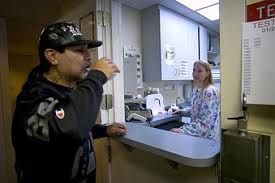Opiate addiction is a complex disorder and many people hold differing views about treatment. A controversial, yet effective drug treatment for teenagers is Methadone. Doctors rarely select Methadone to treat teenage drug addiction, yet it remains one the most effective drugs on the market today.
Today, opiates are a leading drug of choice among school-aged kids. Twenty-five percent of eighth graders have tried illegal drugs. For twelve graders, those statistics become more alarming. These statistics alert us to the epidemic of adolescent drug use and addiction.
Why Kids Abuse Drugs
Many kids use drugs for the same general reasons adults use drugs; to feel happy, stimulated or relaxed; to ease stress and frustration, tension, disappointment or anger. Drug use is primarily to take their minds off any troubles.
Most parents are more familiar with heroin opiates, not fully realizing brand name painkillers like Vicodin and OxyContin, are narcotic opiate drugs, prescribed for treating pain. Kids are more likely to find these opiate drugs right in their home medicine cabinet. The availability of opiates becomes more obvious at schools, where students sell individual pills during the school day.
Treating Teenage Drug Addiction
Drug treatment for adolescents is not that simple. Kids hate the very thought of drug treatment. Listening to boring lectures and having counselors dig deep into the past. Sitting in circles with strangers and forced to place feelings on display. The idea that the school system, court system and parents gang up on them, and force them to get help makes adolescents rebel.
The most effective treatment tends to be Methadone. The program often conflicts with school schedules; however, the bottom line is Methadone treatment is effective with few teens experiencing a relapse.
Very few drug addiction programs offer Methadone treatment to adolescent substance abusers; however, with the number of teen drug users steadily increasing, the question becomes which treatment effectively and quickly stops drug abuse.
Why Methadone Treatment
Methadone is a synthetic product, similar in chemical composition to opiates. Historically, doctors prescribed methadone to patients who were in extreme pain and those in drug addiction programs. Because of the close similarities, Methadone works quickly.
Methadone will greatly prevent the worst of the physical effects of withdrawal. While it may seem counterintuitive to give a drug in order to stop drug addiction, Methadone treatment has the highest success rate of all addiction treatment plans.
Once the patient stabilizes, and their tolerance levels are established, doctors reduce the methadone dosage, thereby weaning the patient.
Behavioral Signs and Symptoms of Opiate Use
Parents often remark they never knew their kids experimented with drugs and few know the marked signs and symptoms. Knowing what to look out for and recognizing the problems can render a faster solution. Here are some behavioral signs and symptoms to alert parents of possible drug use.
- Uncharacteristic mood swings and aggressive behavior
- Truancy and lateness for school or work
- Deterioration in personal hygiene and dress
- Covering up suspicious behavior by lying, being vague, etc
- Unusual conflicts with authority figures
- Sudden change of habits, loss of purpose in life and lack of motivation
- Excessive borrowing of money
- Stealing from family, friends, school
- Selling personal property, with little to show for it
- Deterioration in performance
- Poor appetite and weight loss
- Bouts of depression and shyness
- Spending large periods of time away from home
- Excessive sleeping
Many of these signs may simply be normal signs of adolescence or could be due to some other cause that has nothing to do with drug use. In order to verify your suspicions of possible drug use, it is necessary to back up observations with physical evidence.
Non-Methadone Programs Fall Short
Many of today’s teen drug addiction treatment programs are developed on the premise that the individual is ready to eliminate their substance abuse. These programs frequently function under the assumption that the individual has determined that a drug-free lifestyle is much better for them, however, in reality, someone in authority has made this decision, such as a parent, a probation officer or the juvenile system.
You’ll find, teenagers often refuse to start a drug treatment program. For those willing to try, there is a high rate of relapse. The bottom line is that coercion doesn’t work. Very few teens see the benefit of taking part in drug treatment.
In the last decade, the court system has referred more teenage addicts to drug treatment than any other source. Drug use and criminal behavior have a common link, and courts respond accordingly with drug treatment programs. While the courts, and schools, and parent interventions all provide positive fortification, juveniles are deceptive and most will fail drug treatment, particularly when addiction programs do not include Methadone.
More than 50 percent of teenage students have tried opiates that number is growing at an alarming rate. With such high numbers, parents must choose the best drug addiction programs that have a lasting effect – Methadone treatment tops the list.

